Who Owns The Roads?
Whether you’re a cyclist, a pedestrian, or a driver, roads are important for all of us. We’re here to decode road ownership in Greenville County so you can better understand road-related policies and effectively submit maintenance requests.
On this Page:
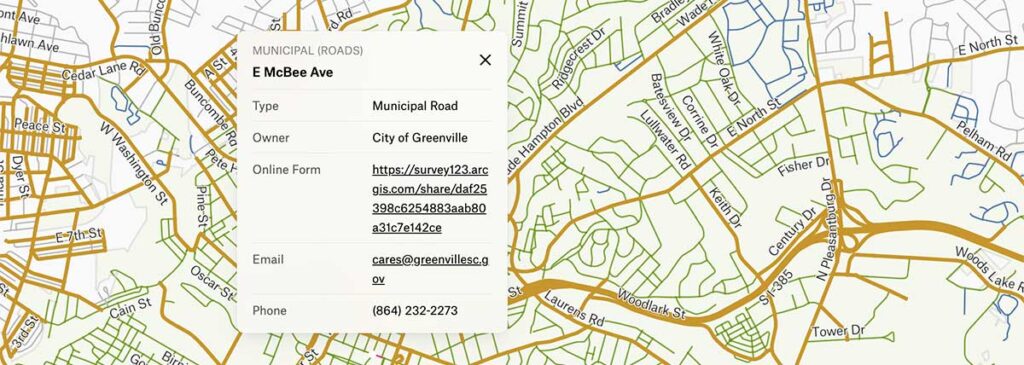
Key Takeaways
Public roads in our county are owned by SCDOT, Greenville County, or one of the 6 cities.
The 6 cities in Greenville County are Greenville, Travelers Rest, Greer, Simpsonville, Mauldin, and Fountain Inn.
The government entity that owns the road is generally responsible for maintenance, repairs, and improvement projects for that road. Road ownership doesn’t necessarily follow municipal boundaries — for example, some roads inside cities are owned by the South Carolina Department of Transportation (SCDOT).
Knowing who owns the road is the first step in reporting an issue.
Identifying who owns the road tells you where to submit a maintenance request. For example, if you notice a pothole on Academy Street near downtown Greenville, you might think you should report it to the City of Greenville. Academy Street, however, is a state-owned road, so you should report it to SCDOT.
It is important to submit maintenance requests to the correct government entity to ensure your concerns are seen by the people with the power to address them.
Why is it important to submit maintenance requests?
The local and state agencies in charge of road maintenance are responsible for many miles of roadway and are often unaware of issues until they are reported by citizens. Submitting a maintenance request alerts the road owner of an issue and may help to address the problem in a timely manner.
Maintenance requests also help local and state agencies identify hot spots where issues frequently occur. The more reports made about an issue, the more likely it is to be addressed.
Interactive Map & Search Tool
Search by Road Name
Data Source: Greenville County GIS
This is a volunteer-led project. If you have suggestions, edits, or corrections, please contact data@bikewalkgreenville.org.
Terminology
Municipal Roads
Owned and maintained by one of the 6 cities in Greenville County.
County Roads
Owned and maintained by Greenville County, including many rural roads
State Roads
Owned and maintained by SCDOT, including the sections of US highways and interstate highways within South Carolina
Private Roads
Owned by individuals, private developers, and homeowners associations
Centerline Miles
The length of a road.
Lane Miles
Owned by individuals, private developers, and homeowners associations.
Right of Way: What is considered part of the road?
You probably know the term “right of way” in reference to which road user has the right to proceed first. Right of Way, or ROW, also refers to the full width of a public street, including the bike lane, sidewalk, median, and shoulder if the road has one.
The entity that owns the road is responsible for all the infrastructure within their ROW, including cyclist and pedestrian infrastructure. ROW width may vary.
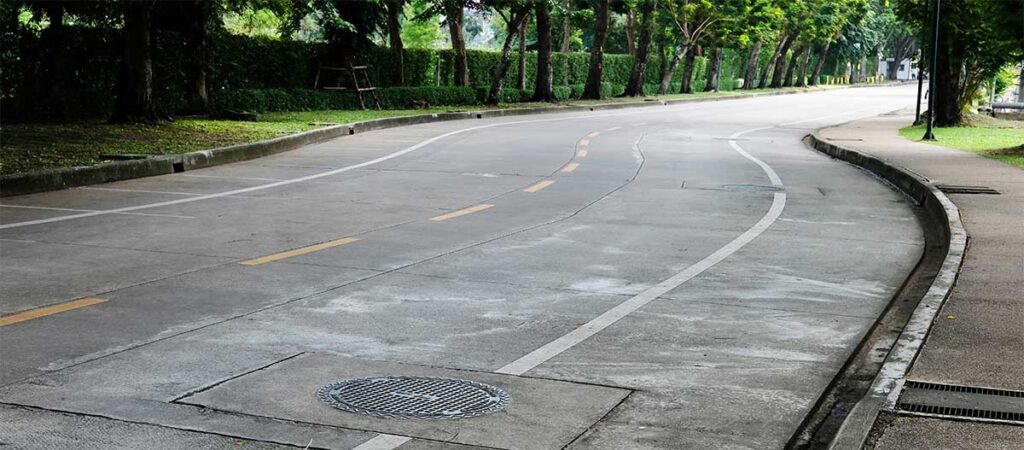
Stats at a Glance
South Carolina has the fourth-largest state-owned road network in the country
Comprising more than 41,000 centerline miles across 46 counties.1
Greenville County has the largest road network of the 46 counties in the state
with 4,525 centerline miles of roads.2
South Carolina is one of the most dangerous states in the country for traffic fatalities.
In 2022, South Carolina had the highest number of traffic fatalities per vehicle miles traveled.3
Greenville County's roads are among the deadliest in South Carolina.
Among the seven most populous counties in South Carolina, Greenville County’s roads accounted for the highest number of fatal crashes and the second highest number of serious injuries between 2017 and 2021. 3
Report a Road Issue
Once you have identified who owns the road, you can submit a maintenance request by calling, texting, emailing, or filling out an online form.
You can report issues like potholes, overgrown sidewalks, debris in the bike lane, and obstructions in the roadway.
Step-by-Step Instructions
City of Greenville
City of Mauldin
Example:
Reporting a Broken Sidewalk to SCDOT
During a walk audit, one of our volunteers encountered a broken sidewalk on W McBee. After checking the road ownership map, he discovered that, at the time, maintenance of W McBee Ave was shared between SCDOT and the City of Greenville.
The broken sidewalk was on the segment maintained by SCDOT. The volunteer filled out a work order form with location details and a photo of the sidewalk ― see the pictures below for each step of the process, which took only a few minutes. Several days later, a work crew repaired the sidewalk.
Since then, SCDOT has transferred ownership of W McBee Ave to the City of Greenville, meaning that the same issue would need to be reported to Greenville Cares if submitted today.
When reporting an issue, first check the map and search tool to confirm the latest ownership information.
Sometimes roads have different names depending on the exact location. Use SCDOT’s Road Information Street Finder (RIS) tool to figure out the specific road name.
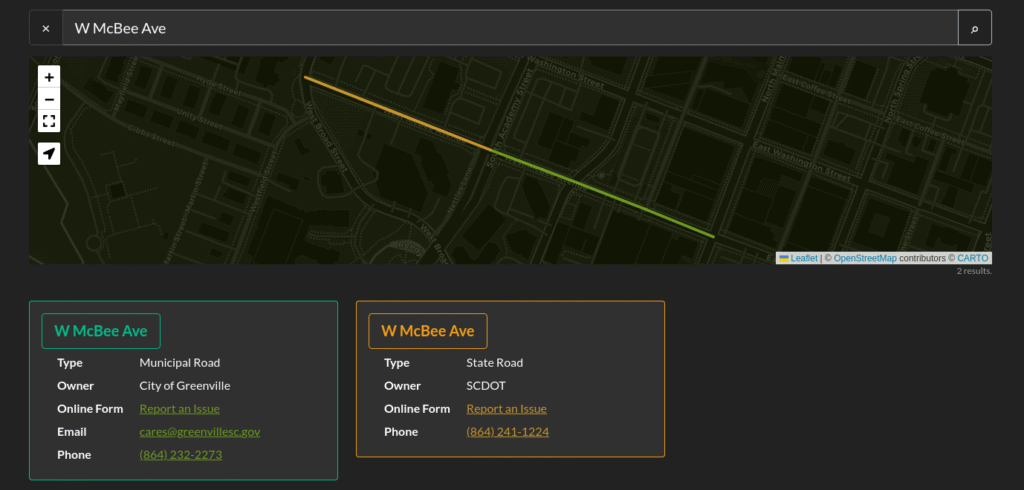
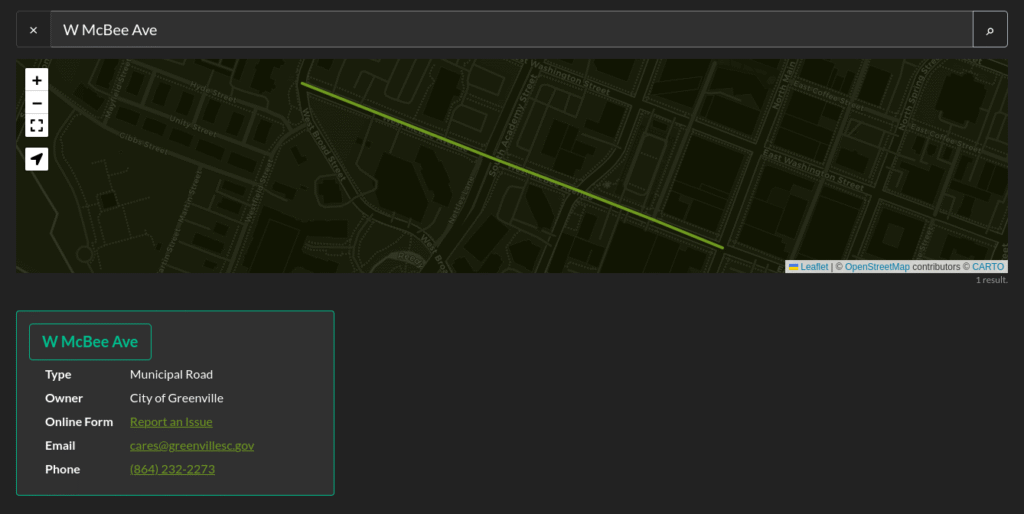
Road Ownership in Greenville County
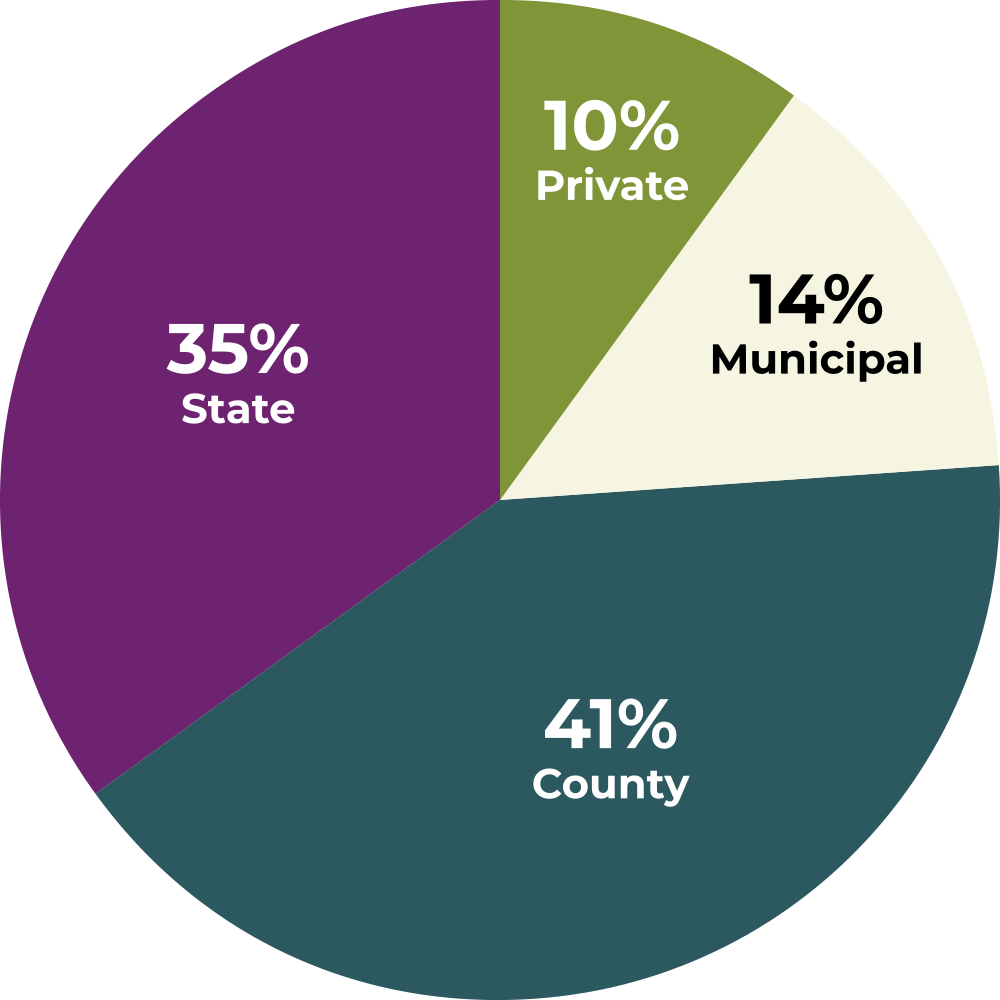
| Road Type | Centerline miles (rounded) | Percentage of total |
|---|---|---|
| Private | 467 | 10% |
| Municipal | 616 | 14% |
| County | 1,850 | 41% |
| State | 1,592 | 35% |
| Total | 4,525 | 100% |
Some places have an unexpected mixture of roads owned by different entities.
Sometimes roads change ownership abruptly.
Differences in road ownership can even impact disaster recovery.
In Sans Souci, the timeliness of debris collection after Hurricane Helene in 2024 varied dramatically from road to road.
Greenville County is the only county among its peers in the state that does not have a one-cent sales tax to fund transportation.
In 2024, Greenville County proposed a 1% capital projects sales tax to raise locally directed funds for roadway improvements. The ‘penny tax’ was projected to raise more than a billion dollars over eight years, but the referendum failed by a narrow margin. Voters in neighboring Spartanburg County approved a 1% sales tax for road repairs in 2023.
The Status of Greenville County Roads
In June 2025, Greenville County Council approved about $33.5 million in the budget for roads, a significant increase from the $8–16 million spent in the past, according to the Post & Courier.
In February 2024, Greenville County staff published a Countywide Infrastructure Inventory and Assessment, concluding that “the condition, performance, and safety of Greenville County’s roadway system is measurably deficient compared to peer counties in South Carolina,” and that “Greenville County significantly underinvests in its roadway system.”
They also concluded that the current state of Greenville County’s roadway system is negatively impacting the quality of life of residents and visitors.
Here are some key takeaways from their assessment:
- 60% of pavement in Greenville County is rated fair or poor condition.
- Crashes resulting in serious injury or death, as well as pedestrian casualties, are concentrated in the urbanized parts of the county.
- In 2023, 79% of transportation funding in Greenville County came from federal and state gas tax revenue.
Funding for State Roads
The federal gas tax and state gas tax are SCDOT’s two largest sources of funding for road maintenance, which together make up more than 80% of the department’s revenues.4
State Gas Taxes
The state gas tax is currently 28¢ per gallon, which is low compared to the gas tax in our neighboring states of Georgia (33¢ per gallon) and North Carolina (40¢ per gallon).
While an important source of funding, the gas tax is becoming less effective for funding roads as vehicles become more fuel efficient.
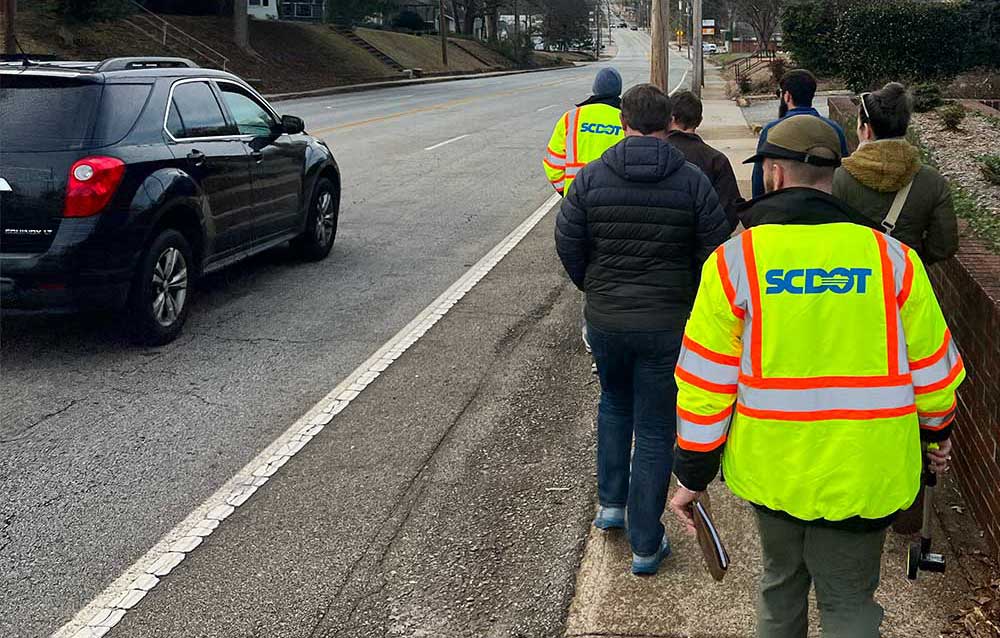
Church Street Bridge Rehabilitation Project
Municipalities can contribute funds for additional improvements to state roads during repair projects, like in the case of the Church Street Bridge Rehabilitation Project.
The City of Greenville contributed $250,000 to improve the aesthetics and safety of the bridge through upgraded lighting, a wider protected pedestrian walkway, and a refresh of the stairway leading to McBee Street. The funds came from the City’s 2% Local Hospitality Tax on prepared meals and beverages sold within City limits.
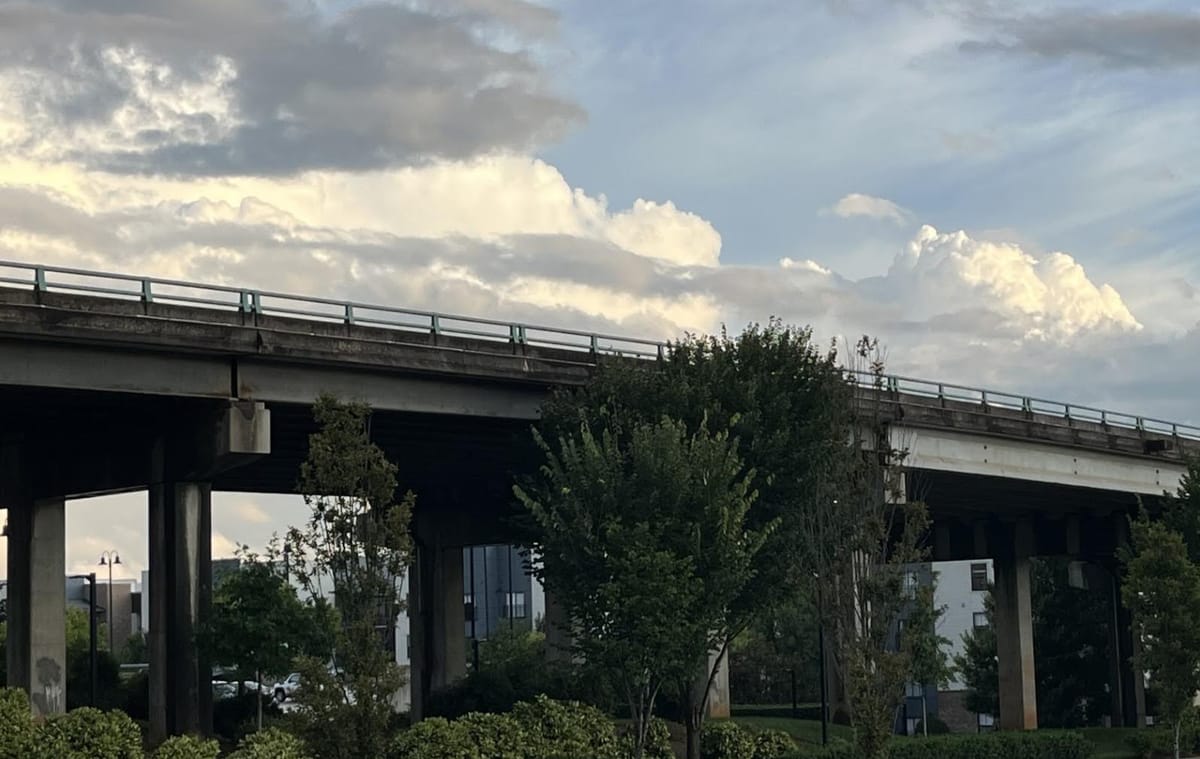
Local vs. State Control
Local priorities are often at odds with the limitations on what SCDOT can do with our roads. The state is responsible for maintaining thousands of miles of roads — from city streets to rural lanes — in areas with vastly different needs, and its focus is often on connecting different parts of the state. SCDOT has limited funds for pedestrian improvements to city streets, for example, when roads and bridges across the state are in need of critical safety upgrades.
The state has made progress toward supporting more pedestrian and cyclist infrastructure, with SCDOT adopting its first Complete Streets policy in 2021. Complete Streets is an approach to road design that takes all road users into account, not just drivers.
The SC House of Representatives’ new SCDOT Modernization Ad-Hoc Committee, formed in May 2025, is considering turning over ownership of some state roads to the counties, according to the Post & Courier.
The biggest challenge for counties and municipalities in taking ownership of more roads is securing enough funding to pay for additional road maintenance.
The City of Greenville is already taking over some roads from the state. On July 14, 2025, Greenville City Council authorized a request to take ownership of portions of several downtown streets from SCDOT. These streets include sections of West Broad Street, Butler Avenue, West McBee Avenue, and Townes Street, and the resolution cites the city’s desire to implement its Complete Streets and urban design standards. Mayor Knox White said the streets were carefully chosen to make them more pleasing for adjacent neighborhoods and to support the city’s economic development and planning process, according to the Greenville Journal.
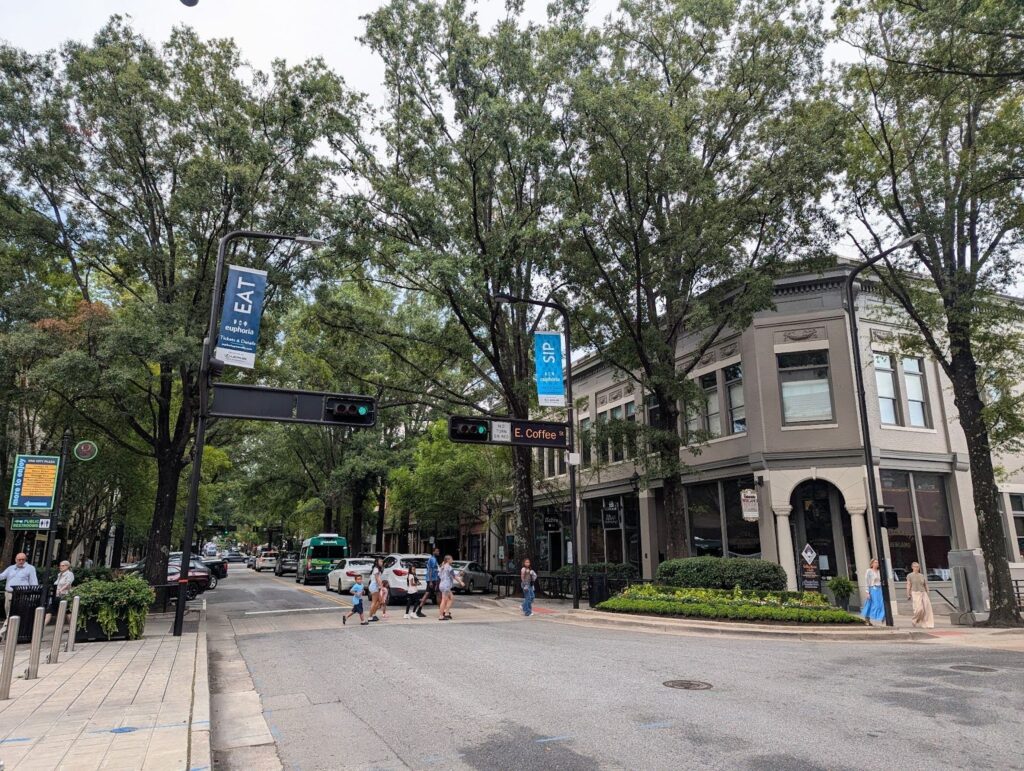
When local governments own the roads, they can make choices reflecting local priorities.
This means deciding when to repair which roads, if and when to establish road diets (reducing the number of car lanes), and which roadway improvements to make (resurfacing, widening sidewalks, adding bike lanes, adding lighting, etc.).
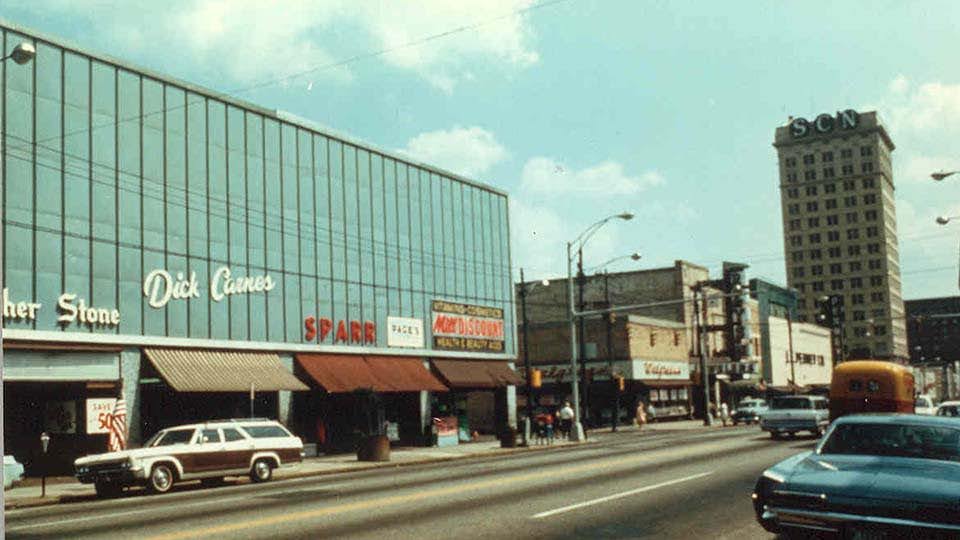
Photo courtesy of the Greenville County Historical Society.
The City of Greenville has transformed streets in the past, like with Main Street in downtown Greenville.
In 1979, the City turned the four-lane highway into a tree-lined two-lane street with wide sidewalks and angled parking, an especially visionary change at the time. The transformation of Main Street was critical in turning downtown Greenville into a beloved destination and an economic powerhouse, attracting businesses, visitors, and residents alike.
Downtown Travelers Rest has experienced its own revitalization over the last few decades, spurred by the Swamp Rabbit Trail. Its Main Street, however, is a state route with four lanes and a center turn lane.
State Departments of Transportation usually prioritize moving car traffic efficiently, while municipalities with public input processes tend to prioritize slowing car traffic and creating spaces that are safer for pedestrians.
The ability to make decisions locally to reflect the needs of the community is key when it comes to creating spaces that serve residents and visitors, rather than just drivers passing through.
Paving Schedules
Use the resources below to see if a road you’re concerned about is on the schedule to be repaved.
Get Involved
Want to get involved with Bike Walk Greenville’s efforts to advocate for safe, equitable, and accessible active transportation choices in Greenville County?
- Sign up for our newsletter to stay up-to-date with news, projects, events, and upcoming volunteer opportunities.
- Complete our volunteer form to tell us about your areas of interest and expertise.
References
- “Frequently Asked Questions.” South Carolina Department of Transportation
- “Greenville County’s Transportation Challenge.” ArcGIS StoryMaps, Esri, 4 Mar. 2024.
- “Addressing America’s Traffic Safety Crisis Report Appendix.” TRIP – A National Transportation Research Nonprofit, June 2023.
- “Budget.” South Carolina Department of Transportation.
Credits
- Data engineering: Bennett Meares
- Mapping: Colby Poplin
- Writing: Summer Meares
- Fact checking and research: Alex Shipp
- Editing: Claire Windsor, Mary McGowan, Lauren Prunkl, Jasmine Vanadore
- Web design: Jason Pleakis, Greenville Web Works
- With support from: Ben Lord, Tim Simpson, Mike Nice